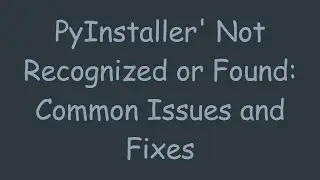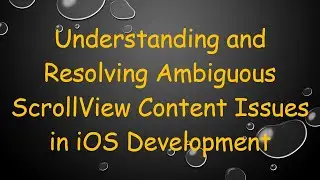Best Practices for Alt Text: Enhancing Accessibility and SEO
Discover the best practices for writing alt text, ensuring accessibility and improving SEO for your website's images. Explore tips for crafting descriptive, concise, and contextually relevant alt text that benefits all users.
---
Disclaimer/Disclosure: Some of the content was synthetically produced using various Generative AI (artificial intelligence) tools; so, there may be inaccuracies or misleading information present in the video. Please consider this before relying on the content to make any decisions or take any actions etc. If you still have any concerns, please feel free to write them in a comment. Thank you.
---
Alt text, short for alternative text, plays a crucial role in web accessibility and search engine optimization (SEO). When properly utilized, alt text enhances the user experience for individuals with visual impairments and boosts the discoverability of web content. Here are some best practices for writing alt text:
Be Descriptive: Alt text should accurately describe the content and function of the image. Provide details that convey the purpose and context of the image to users who cannot see it.
Keep it Concise: While being descriptive, aim for brevity. Avoid long, overly verbose alt text that may overwhelm users or disrupt the flow of content.
Include Keywords: Incorporate relevant keywords that reflect the subject matter of the image and align with your overall SEO strategy. However, prioritize clarity and relevance over keyword stuffing.
Focus on Context: Consider the surrounding content and the page's overall context when writing alt text. Ensure that the description complements the surrounding text and provides meaningful information to users.
Use Punctuation Sparingly: Alt text is typically read aloud by screen readers, so use punctuation judiciously to maintain readability. Avoid excessive punctuation that may confuse or disrupt the flow of the description.
Identify Functional Images: Differentiate between decorative and functional images. Decorative images, such as background patterns or design elements, may not require alt text or can have empty alt attributes (alt=""). Functional images, such as buttons or icons with actionable features, should have descriptive alt text.
Avoid Repetition: If an image is already described in nearby text, consider whether additional alt text is necessary. Repetitive alt text can be redundant and may detract from the user experience.
Provide Contextual Information: For complex images, charts, or graphs, provide additional context within the surrounding text or use long descriptions (longdesc) to offer detailed explanations.
Test for Accessibility: Use accessibility tools and assistive technologies, such as screen readers or browser extensions, to evaluate the effectiveness of your alt text. Ensure that it provides meaningful information to users with disabilities.
Update Alt Text Regularly: Regularly review and update alt text as needed, especially when content or images change. Stay proactive in maintaining accessibility and relevance across your website.
By following these best practices, you can create alt text that enhances the accessibility of your website and improves its search engine visibility. Remember that alt text benefits all users, making web content more inclusive and informative.































